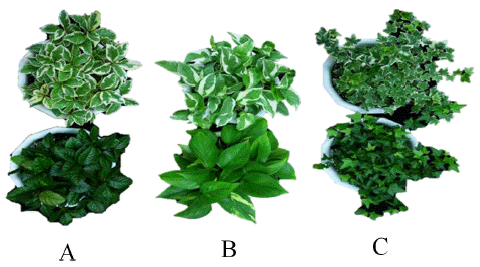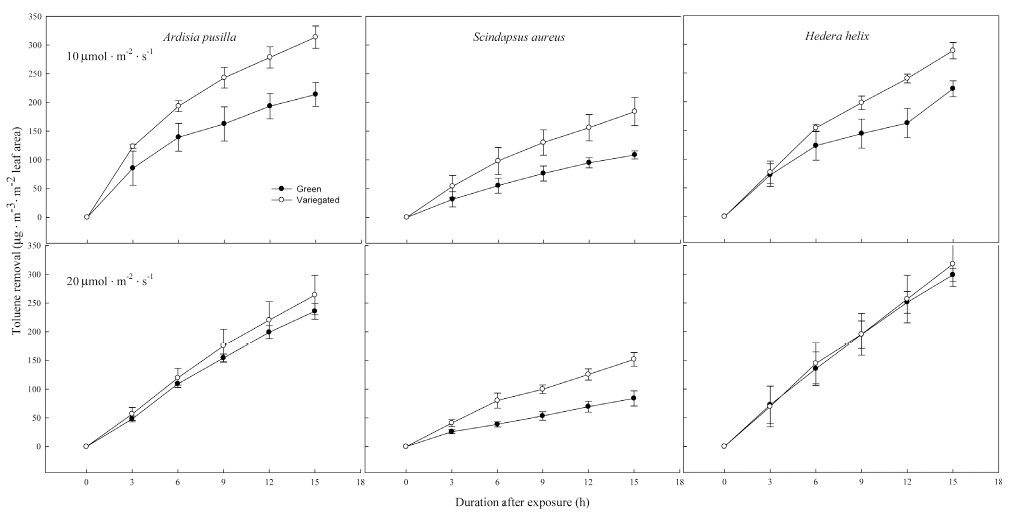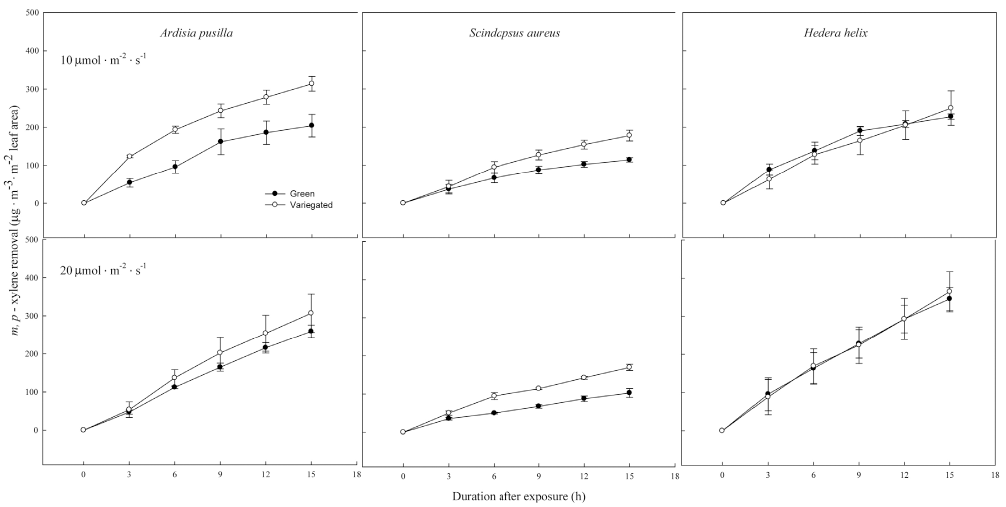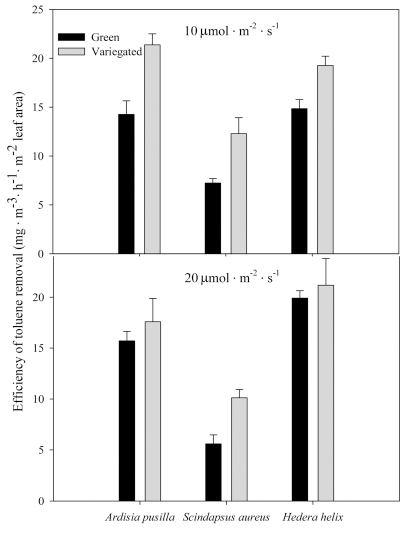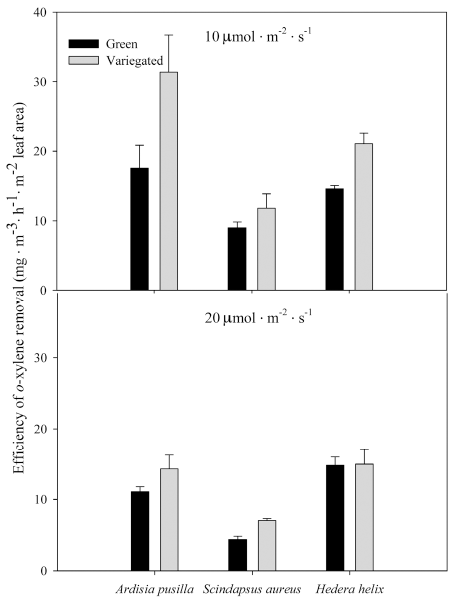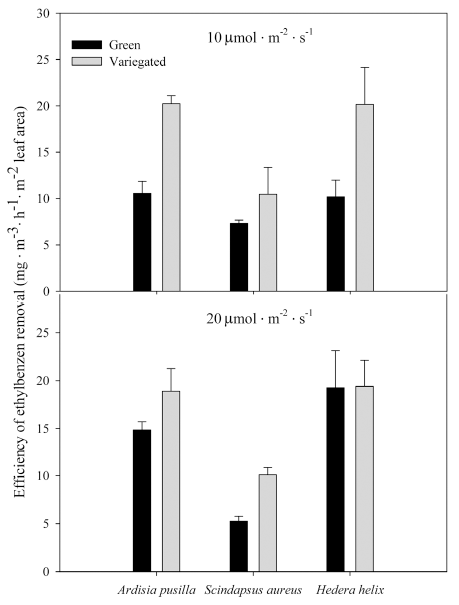Aydogan, A., L.D. Montoya. Formaldehyde removal by common indoor plant species and various growing media. Atmos. Environ.. 2011. 45:2675-2682. PMID:
10.1016/j.atmosenv.2011.02.062

Baosheng, K., S. Shibata, A. Sawada. Air purification capability of potted Phoenix roebelenii and its installation effect in indoor space. Sens. Mater.. 2009. 21(8):445-455.
Beerling, D.J., F.I. Woodward. Stomatal responses of variegated leaves to CO2 enrichment. Ann. Bot.. 1995. 75(5):507-511. PMID:
10.1006/anbo.1995.1052

Brown, S.K. Volatile organic compounds in indoor air: Source and control. Chem. Aust. 1997. 64:10-13.
Campitelli, B.E., I. Stehlik, J.R. Stinchcombe. Leaf variegation is associated with reduced herbivore damage in Hydrophyllum virginianum. Botany. 2008. 86(3):306-313. PMID:
10.1139/B07-139

Chen, J., R.J. Henny. Ornamental foliage plants: Improvement through biotechnology. Recent advances in plant biotechnology and its applications. New Delhi: IK International Publishing House Pvt. Ltd.. 2008. (pp. 140-156).
Chen, Y.S., P. Chesson, H.W. Wu, S.H. Pao, J.W. Liu, L.F. Chien, J.W. Yong, C.R. Sheue. Leaf structure affects a plantŌĆÖs appearance: combined multiple-mechanisms intensify remarkable foliar variegation. J. Plant Res.. 2017. 130(2):311-325. PMID:
10.1007/s10265-016-0890-4


Dela Cruz, M., J.H. Christensen, J.D. Thomsen, R. MA1/4ller. Can ornamental potted plants remove volatile organic compounds from indoor air? - A review. Environ. Sci. Pollut. Res. Int.. 2014. 21(24):13909-13928. PMID:
10.1007/s11356-014-3240-x


Feng, Y.L., K.F. Cao, J.L. Zhang. Photosynthetic characteristics, dark respiration, and leaf mass per unit area in seedlings of four tropical tree species grown under three irradiances. Photosynthetica. 2004. 42(3):431-437. PMID:
10.1023/B:PHOT.0000046163.83729.e5

Fisk, W.J. 2000 Review of health and productivity gains from better IEQ. https://escholarship.org/content/qt57c3z448/qt57c3z448.pdf
Hines, A.L., T.K. Ghosh, S.K. Loylka, R.C. Warder. Indoor air: Quality and control. Englewood Cliffs, N.J., USA: Prentice Hall. 1993.
Irga, P.J., F.R. Torpy, M.D. Burchett. Can hydroculture be used to enhance the performance of indoor plants for the removal of air pollutants? Atmos. Environ.. 2013. 77:267-271. PMID:
10.1016/j.atmosenv.2013.04.078

Khalekuzzaman, M., K.J. Kim, H.J. Kim, H.H. Jung, H.S. Jang. Comparison of green and variegated foliage plant species based on chlorophyll fluorescence parameters under different light intensities. Pak. J. Bot.. 2015. 47:1709-1715.
Kil, M.J., K.J. Kim, J.K. Cho, C.H. Park. Formaldehyde gas removal effects and physiological responses of Fatsia japonica and Epipremnum aureum according to various light intensity. Weonye Gwahag Gisulji. 2008. 26(2):189-896.
Kim, K.J., E.H. Yoo, S.J. Kays. Decay kinetics of toluene phytoremediation stimulation. HortScience. 2012. 47(8):1195-1198.

Kim, K.J., E.H. Yoo, M.I. Jeong, J.S. Song, S.Y. Lee, S.J. Kays. Changes in the phytoremediation potential of indoor plants with exposure to toluene. HortScience. 2011. 46(12):1646-1649.

Kim, K.J., H.H. Jung, H.W. Seo, J.A. Lee, S.J. Kays. Volatile toluene and xylene removal efficiency of foliage plants as affected by top to root zone size. HortScience. 2014. 49(2):230-234.

Kim, K.J., M.I. Jeong, D.W. Lee, J.S. Song, H.D. Kim, E.H. Yoo, S.J. Jeong, S.W. Han, S.J. Kays, Y.W. Lim, H.H. Kim. Variation in formaldehyde removal efficiency among indoor plant species. HortScience. 2010. 45(10):1489-1495.

Kim, K.J., M.J. Kil, J.S. Song, E.H. Yoo, K.C. Son, S.J. Kays. Efficiency of volatile formaldehyde removal by indoor plants: Contribution of aerial plant parts versus the root zone. J. Am. Soc. Hortic. Sci.. 2008. 133(4):521-526.

Kondo, T., K. Hasegawa, R. Uchida, M. Onishi, A. Mizukami, K. Omasa. Absorption of formaldehyde by oleander (Nerium indicum). Environ. Sci. Technol.. 1995. 29(11):2901-2903.


Liu, X. Identification of appropriate CFD models for simulating aerosol particle and droplet indoor transport. Indoor Built Environ.. 2007. 16(4):322-330. PMID:
10.1177/1420326X06079890

Maloof, J.N., J.O. Borevitz, T. Dabi, J. Lutes, R.B. Nehring, J.L. Redfern, J.T. Trainer, J.M. Wilson, T. Asami, C.C. Berry, D. Weigel, J. Chory. Natural variation in light sensitivity of Arabidopsis. Nat. Genet.. 2001. 29:441-446. PMID:
10.1038/ng777


Manaker, G.H. Interior plantscapes: Installation, maintenance, and management. (3rd ed.). Upper Saddle River, N.J., USA: Prentice Hall. 1997.
Mansfield, T.A., A.M. Hetherington, C.J. Atkinson. Some current aspects of stomatal physiology. Annu. Rev. Plant Physiol. Plant Mol. Biol.. 1990. 41:55-75. PMID:
10.1146/annurev.pp.41.060190.000415

Marcotrigiano, M. Chimeras and variegation: Patterns of deceit. HortScience. 1997. 32(5):773-784.

Orwell, R.L., R.L. Wood, J. Tarran, F. Torpy, M.D. Burchett. Removal of benzene by the indoor plant/substrate microcosm and implications for air quality. Water Air Soil Pollut.. 2004. 157(1-4):193-207. PMID:
10.1023/B:WATE.0000038896.55713.5b

Orwell, R.L., R.L. Wood, M.D. Burchett, J. Tarran, F. Torpy. The potted-plant microcosm substantially reduces indoor air VOC pollutant: II. Laboratory study. Water Air Soil Pollut.. 2006. 177(1-4):59-80. PMID:
10.1007/s11270-006-9092-3

Oyabu, T., A. Sawada, H. Kuroda, T. Hashimoto, T. Yoshioka. Purification capabilities of golden pothos and peace lily for indoor air pollutants and its application to a relaxation space. Nogyo Kisho. 2005. a 60(6):1145-1148. PMID:
10.2480/agrmet.1145

Oyabu, T., T. Onodera, A. Sawada, M. Tani. Purification characteristics of golden pothos for emitting airpollutants from plywood using a gas sensor. WIT Trans. Biomed. Health.. 2005. b 9:9PMID:
10.2495/EHR050241

Pao, S.H., P. Chesson, C.I. Peng, W.B. Yeh, C.R. Sheue. 2014;Characteristics and ecological significance of natural variegation from Begonia formosana. The 99th Annual Meeting 10th-15th August; Ecological Society of America; Sacramento, California, USA.
Roelfsema, M., R. Hedrich. In the light of stomatal opening: new insights into ŌĆ£The WatergateŌĆØ. New Phytol.. 2005. 167(3):665-691. PMID:
10.1111/j.1469-8137.2005.01460.x


Runeson, R., K. Wahlstedt, G. Wieslander, D. Norback. Personal and psychological factors and symptoms compatible with sick building syndrome in the Swedish workforce. Indoor Air. 2006. 16(6):445-453. PMID:
10.1111/j.1600-0668.2006.00438.x


Sawada, A., T. Oyabu. Purification characteristics of pothos for airborne chemicals in growing conditions and its evaluation. Atmos. Environ.. 2008. 42(3):594-602. PMID:
10.1016/j.atmosenv.2007.10.028

Sims, D.A., R.W. Pearcy. Response of leaf anatomy and photosynthetic capacity in Alocasia macrorrhiza (Araceae) to a transfer from low to high light. Am. J. Bot.. 1992. 79(4):445-449.

Tsai, D.H., J.S. Lin, C.C. Chan. Office worker ?(tm)s sick building syndrome and indoor carbon dioxide concentrations. J. Occup. Environ. Hyg.. 2012. 9(5):345-351. PMID:
10.1080/15459624.2012.675291


Torpy, F.R., P.J. Irga, D. Moldovan, J. Tarran, M.D. Burchett. Characterization and biostimulation of benzene biodegradation in the potting-mix of indoor plants. J. Appl. Hortic.. 2013. 15(1):10-15.

Wang, B.L., T. Takigawa, A. Takeuchi, Y. Yamasaki, H. Kataoka, D.H. Wang, K. Ogino. Un-metabolized VOCs in urine as biomarkers of low level exposure in indoor environments. J. Occup. Health.. 2007. 49(2):104-110.


Wolverton, B.C., J.D. Wolverton. Plants and soil micro-organisms-removal of formaldehyde, xylene and ammonia from the indoor environment. J. Miss. Acad. Sci.. 1993. 38(2):11-15.
Yoo, M.H., Y.J. Kwon, K.C. Son, S.J. Kays. Efficacy of indoor plants for the removal of single and mixed volatile organic pollutants and physiological effects of the volatiles on the plants. J. Am. Soc. Hortic. Sci.. 2006. 131(4):452-458.

